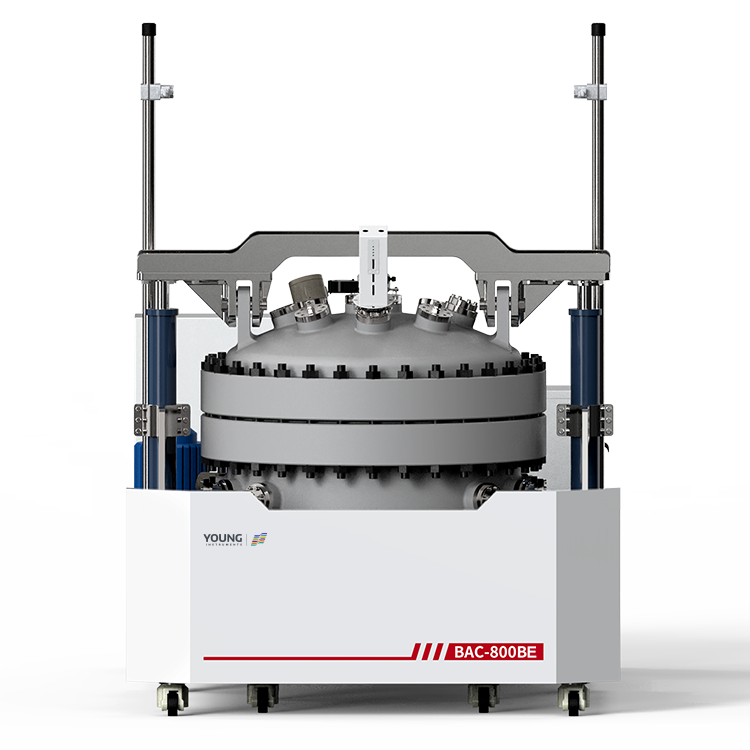Battery Hazard Screening – Assessment of Safety in Small-Scale Single-Cell Thermal Runaway
Battery Hazard Screening is widely used across vital industries like new energy vehicles, energy storage, consumer electronics, and aerospace, prompting considerable societal concern over their safety. Thermal runaway, a primary factor in lithium battery safety incidents, can result in fires or explosions, directly endangering user safety.
Introduction to BAC-90AE Small Battery Adiabatic Calorimeter
The Small Battery Adiabatic Calorimeter BAC-90AE is an advanced safety testing device that evolved from traditional adiabatic calorimeters. It is specifically engineered for testing the safety of small batteries. This tool excels in capturing detailed safety performance data under varied abuse conditions, integrating the synchronized collection of battery voltage, current, energy, temperature, pressure, and time.
Core Functions and Capabilities
The BAC-90AE creates an ideal adiabatic environment to accurately measure thermal behavior parameters, such as the onset temperature of battery thermal runaway, the maximum rate of temperature rise, and adiabatic temperature increase. It features an integrated battery charge/discharge module that allows for seamless mode switching and precise control over charging conditions. This module facilitates constant current and voltage charging settings, alongside charge/discharge current settings, and calculates battery capacity in real time. The calorimeter can simultaneously acquire data on battery voltage, current, temperature, and pressure, making it invaluable for thermal runaway analysis.
Enhanced Safety Features and Standards Compliance
In addition to its technical capabilities, the BAC-90AE includes numerous safety features to ensure secure operation. These include overpressure and overtemperature alarms, as well as an automatic furnace lid lifting mechanism for enhanced safety during testing. The calorimeter adheres to stringent standards, including ASTM E1981-98 and SN/T3078.1, ensuring compliance with international safety testing protocols. Its ability to perform specific heat tests under constant power and rate further enhances the accuracy of thermal measurements, solidifying its role as a critical tool in battery safety assessment.
Zeal Instruments’ Small Battery Adiabatic Calorimeter for Comprehensive Thermal Runaway Assessment
The small battery adiabatic calorimeter from Battery Hazard Screening can assess the thermal runaway safety of small individual cells. It can measure cylindrical cells, square cells, and pouch cells, and the parameters measured include the following:
| Tonset | Onset temperature of heat release in lithium-ion batteries under thermal runaway. |
| Tcr | Critical temperature for thermal runaway in lithium-ion batteries. |
| (dT/dt)max | Maximum self-heating rate during thermal runaway in lithium-ion batteries. |
| △Tad | Adiabatic temperature rise of lithium-ion batteries under thermal runaway. |
| TD24 | Temperature at which the heat release reaction reaches (dT/dt)max under adiabatic conditions after 24 hours. |
| TMRad | Time taken for the heat release reaction to reach (dT/dt)max under adiabatic conditions. |
| Pmax | Maximum pressure reached during the heat release reaction of thermal runaway. |
| Pf | Pressure returned to at ambient temperature after the heat release reaction of thermal runaway. |
| Δn | Gas generation at ambient temperature after the heat release reaction or thermal runaway of lithium-ion batteries. |
Utilizing the Small Battery Adiabatic Calorimeter for Comprehensive Testing
The Small Battery Adiabatic Calorimeter is instrumental in conducting low-temperature cycling aging tests on NCA811 lithium-ion batteries. It enables a detailed analysis of the State of Health (SOH) concerning specific heat capacity, heat generation characteristics, and gas generation properties. This tool provides a holistic approach to enhancing battery performance and safety.

Assessing Specific Heat Capacity
- Importance of Specific Heat Capacity: Specific heat capacity is crucial in transient simulations within lithium battery thermal management systems. It serves as the foundation for quantifying how much heat a battery generates and transfers during operation. This parameter is essential for understanding and modeling the thermal behavior of batteries, which directly influences their performance and safety.
- Measurement Techniques: The Small Battery Adiabatic Calorimeter is designed to measure the specific heat capacity of battery cells with high precision. By isolating the battery in an adiabatic environment, the calorimeter ensures that the measurements of heat absorption and release are accurate, providing reliable data that is vital for optimizing battery thermal management strategies.
- Implications for Battery Design: Accurately measuring the specific heat capacity helps in designing lithium batteries that can effectively manage heat. This is crucial for maintaining optimal operating temperatures, thus enhancing battery efficiency and extending its lifespan. By understanding and controlling the heat generation and transfer characteristics, engineers can develop batteries that are not only safer but also have a higher capacity and longer life, essential for applications in high-demand settings like electric vehicles and renewable energy storage systems.
Evaluating Charge/Discharge Heat Generation
- Impact of Aging on Heat Generation: Battery aging can alter the amount and rate of heat generation, which significantly affects both the lifespan and safety of lithium-ion batteries. Understanding these changes is crucial for maintaining battery reliability over time.
- Role of the Adiabatic Calorimeter: The Small Battery Adiabatic Calorimeter is equipped with a sophisticated charge/discharge module that precisely measures the heat released during battery operation. This tool allows for the detailed tracking of heat generation patterns, providing insights into how aging affects battery performance.
- Enhancing Battery Safety and Efficiency: By monitoring heat generation data, the calorimeter plays a vital role in detecting aging effects early. This information is used to develop strategies that mitigate these effects, thereby enhancing the battery’s overall safety and operational efficiency. Such proactive measures ensure that the battery systems remain robust and perform optimally throughout their intended lifespan.
Analyzing Thermal Runaway and Gas Generation
- Understanding Thermal Runaway:Thermal runaway in batteries can lead to catastrophic failures. The Small Battery Adiabatic Calorimeter utilizes the Heat-Wait-Search (HWS) mode to accurately capture the critical parameters that signal the onset of thermal runaway. This mode helps in identifying the specific conditions under which batteries become unstable.
- Synchronized Testing for Gas Analysis:The calorimeter enhances its testing capabilities by synchronizing the measurement of thermal runaway gas pressure and the collection of gases in custom-sealed chambers. This setup allows for a precise analysis of the gases emitted during thermal incidents, providing valuable insights into the chemical and physical changes occurring within the battery.
- Enhancing Safety and Efficiency: By analyzing the gases released during thermal runaway, the calorimeter helps in understanding the operational risks associated with battery use. This analysis is essential for developing robust safety measures and improving battery design, ensuring safer and more efficient battery technologies for a variety of applications.
Final Thoughts: Battery Hazard Screening
Evaluating safety in small-scale single-cell thermal runaways via battery hazard screening is crucial for advancing battery technology and safeguarding users. Utilizing advanced tools such as the Small Battery Adiabatic Calorimeter enables precise measurement and analysis of specific heat capacity, heat generation during charge/discharge cycles, and gas behavior in thermal runaway scenarios. This thorough analysis identifies risks and supports the creation of safer battery designs and robust thermal management systems. Ultimately, these assessments play a pivotal role in enhancing the reliability and safety standards of lithium-ion batteries across diverse applications.




































